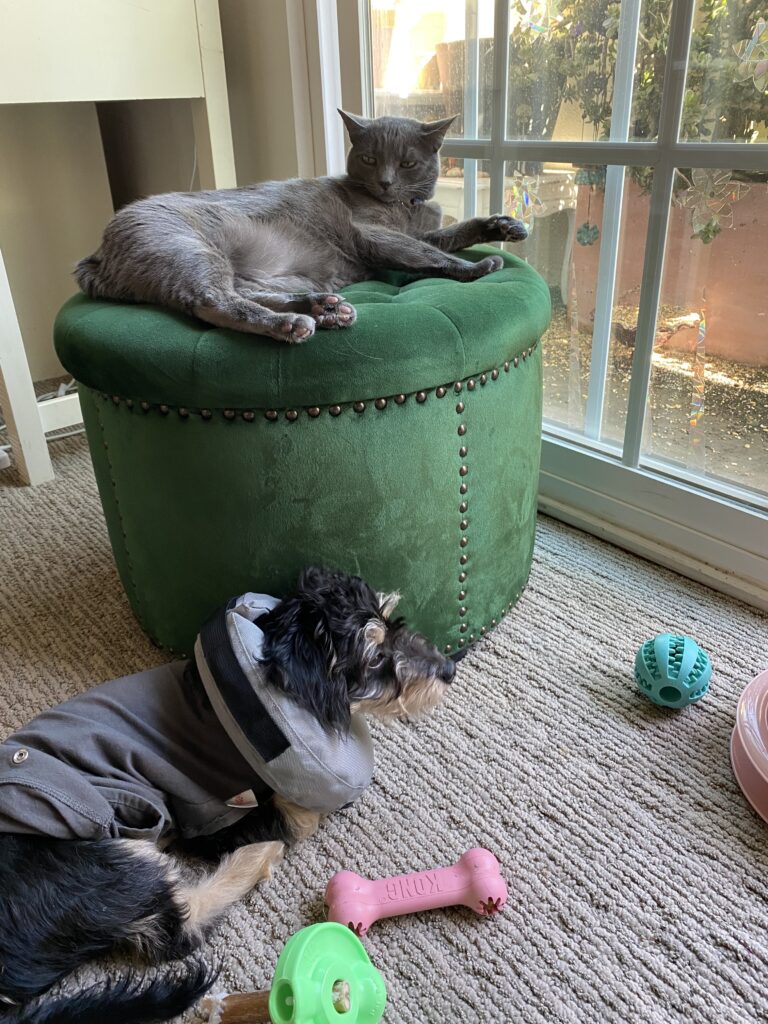And we are back. January was a scary month for us in Los Angeles. It’s better now that we have rain, but we have much work to do to rebuild. I digress to update you on why I haven’t posted in a month. All of that to say, dogs and cats can live harmoniously together. I have done it, and it worked. It does take time and patience for them to trust each other. It may seem challenging for dogs and cats, but it’s possible with the right approach. While their instincts and communication styles differ, dogs and cats can form lasting bonds and live happily under the same roof. Here’s a guide to a peaceful cohabitation between your fur kids.

Understanding Their Differences
Dogs and cats have distinct behavioral traits and ways of communicating, and understanding these differences can help you manage their interactions effectively and have a peaceful home:
- Body Language: Dogs often wag their tails when happy, but cats might lash their tails when annoyed or agitated.
- Territorial Instincts: Cats are typically more territorial and may need their own safe space, especially when a new dog enters the home.
- Social Structures: Dogs are pack animals and may seek to establish dominance, while cats are more independent and prefer to dictate their terms. It’s always on the cat’s terms, am I right, cat parents?
Steps to a Successful Introduction
The dog and cat introduction requires some planning and patience. Follow these steps to set them up for success:
- Choose the Right Time:
- Make introductions when both pets are calm. Avoid stressful times right after a move or during significant household changes.
- Use Separate Spaces:
- Initially, keep the dog and cat in separate areas, swapping blankets or toys to allow them to become familiar with each other’s scent.
- Controlled First Meeting:
- Keep the dog on a leash and let the cat approach on its terms. Ensure the dog remains calm and doesn’t lunge or bark.
- Positive Reinforcement:
- Reward both pets with treats and praise for calm behavior. This helps them associate each other’s presence with positive experiences.
- Gradual Increase in Interaction:
- Allow supervised interactions over time. Gradually increase the duration as both pets show signs of comfort and interest in each other.
Create a Pleasent and Safe Environment
For dogs and cats to coexist peacefully, your home should accommodate their unique needs:
- Provide Separate Safe Spaces:
- Cats should have high perches or private areas where they can retreat if they feel overwhelmed. Like a cat tree (I have three), a table, a tall chair, and/or cat shelves. That way, they can jump to safety quickly.
- Establish Feeding Zones:
- Feed pets in separate locations to prevent competition or stress during mealtimes. A baby gate is a helpful tool as well.
- Train Your Dog:
- Teach your dog basic commands like “sit,” “stay,” and “leave it” to ensure they can control their impulses around the cat.
- Keep Litter Boxes Private:
- Place litter boxes in areas inaccessible to the dog to maintain the cat’s comfort and privacy.
- Monitor Playtime:
- Ensure that play doesn’t become too rough. Cats and dogs have different play styles, and misunderstandings can lead to stress or conflict.
Recognizing Compatibility
Some dog and cat personalities naturally mesh better than others. Here are traits to consider:
- Dog Breeds: Breeds with low prey drives, such as Golden Retrievers, Beagles, and Cavalier King Charles Spaniels, as well as many mixed breeds, are often more compatible with cats.
- Cat Temperaments: Confident and social cats are more likely to adapt well to sharing their space with a dog.
- Age and Energy Levels: Pairing a calm, older cat with a high-energy puppy might lead to friction, whereas a kitten and a young dog may grow up bonding naturally.
Common Challenges and How to Address Them
Even with the best preparation, challenges may arise. Here’s how to handle them:
- Chasing Behavior:
- When they chase the cat, redirect your dog’s attention with toys or training.
- Resource Guarding:
- If either pet guards food, toys, or spaces, provide separate areas and discourage possessive behavior through training.
- Fear or Aggression:
- Give both pets time to adjust and seek professional advice if either exhibits persistent fear or aggression.


Benefits of Dogs and Cats Co-Habitating
- Companionship: Dogs and cats can comfort and companion each other, reducing loneliness when their humans are away.
- Enrichment: Watching pets interact and play can bring joy and entertainment to your household.
- Mutual Learning: Dogs and cats often learn from each other, adopting new behaviors or routines that enrich their lives.
Dogs and cats can live and get along well with patience, understanding, and proper training.
You can create a loving and peaceful home for both fur children by respecting their needs and fostering a positive experience and interactions. Remember, every pet is unique; some may take longer to adjust.
Your dog and cat can go from concerned acquaintances to lifelong BFFs with effort and care. You can do it; we believe in you!